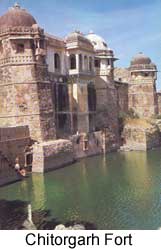

 |  |
|

A still silence hangs over the deserted pavilions and the ruined temples of Chitorgarh. Three times in its history, the Sisodia princes of Mewar led their warriors from its walls to carry death to the besiegers or meet it in the field. Three times they left behind them the terrible Johar, the voluntary immolation of their women and children in order to save their honour from the enemies. Death for all before dishonour. This fort was not easy to take. 500 feet above the plains, the walls of Chitorgarh are the finest Hindu defence work to survive in any degree of completeness. Though the merlons in the crenellations have a typically Muslim pointed arch profile, the embrasures splay out from narrow slits below a string course to produce rare wedge shaped forms. There is one northern gate and one on the eastern wall. But the main approach is from the west and here across the sinuous route, are seven massive gates : Badal, Bhairon, Hanuman, Ganesha, Jarlan, Lakhama and finally, the vast Ram Pol, built in 1459 on a richly moulded base like those of the Hindu temples. There is a mandapa, a temple hall provided shelter for the guard. Crosswalls link the 2nd, 4th, 5th, 6th gates to the main ramparts. In 1303, when young Rana Lakhuar Singh was the reigning chief of the palace, Ala-ud-din Khilji laid down the siege to Chitorgarh in order to abduct his wife Padmini whose legendary beauty was highly appraised. Padmini, however along with several thousands of other Rajput women performed Johar to save her honour from the enemies. The muslims always invaded for wealth and women. The Rajput, after putting up a brave show, lost to the mighty army of Khilji. The palace of Rani Padmini stands in a pool of water. The reign of the brave Rajputs was marked with the great Nakkaras, the huge kettledrums that proclaimed for miles around the exit and the entrances of the Ranas. The standard of Mewar, a brilliant solar disk, flew from the ramparts. Rana Khumba of Chitorgarh, after defeating Sultan Mahmud of Malwa in 1458, built the famous Jayastambha., the tower of victory. Nine storeys and 120 feet high, each tier, a mandapa for its associated temple and enriched with balconied windows, is carved profusely with the Gods of the Hindu Pantheon. Many priceless inscriptions inside were later destroyed but one remains: 'Sparkling like the first rays of the sun, the tower rose like the bride of the earth'. The principal entrance is to the east into a stable court past a guard house. Beyond is the durbar court, beyond that the private apartments and, secure at its heart, the zenana. Age old traditions of the prasada is revived in the multi storeyed ways with their balconies and terrace, and many earlier remains were incorporated in the 15th century rebuilding, like the Khumbhashayana temple and, standing by the tank or Gaumukh Kund, the samidhishwar temple. There are several Jain shrines from between the 11th and 14th centuries, including the Mahadeva and the Shantinath temples, intricately carved with Gods and Goddeses, celestial dancers and musicians caught in attitudes of bliss from joy at their music making. |
Copyright ©2000 indiansaga.info. All rights reserved.
By using this service, you accept that you won't copy or use the data given in this website for any commercial purpose.
The material on indiansaga.info is for informational & educational purpose only.
This site is best viewed at 800 X 600 picture resolution.